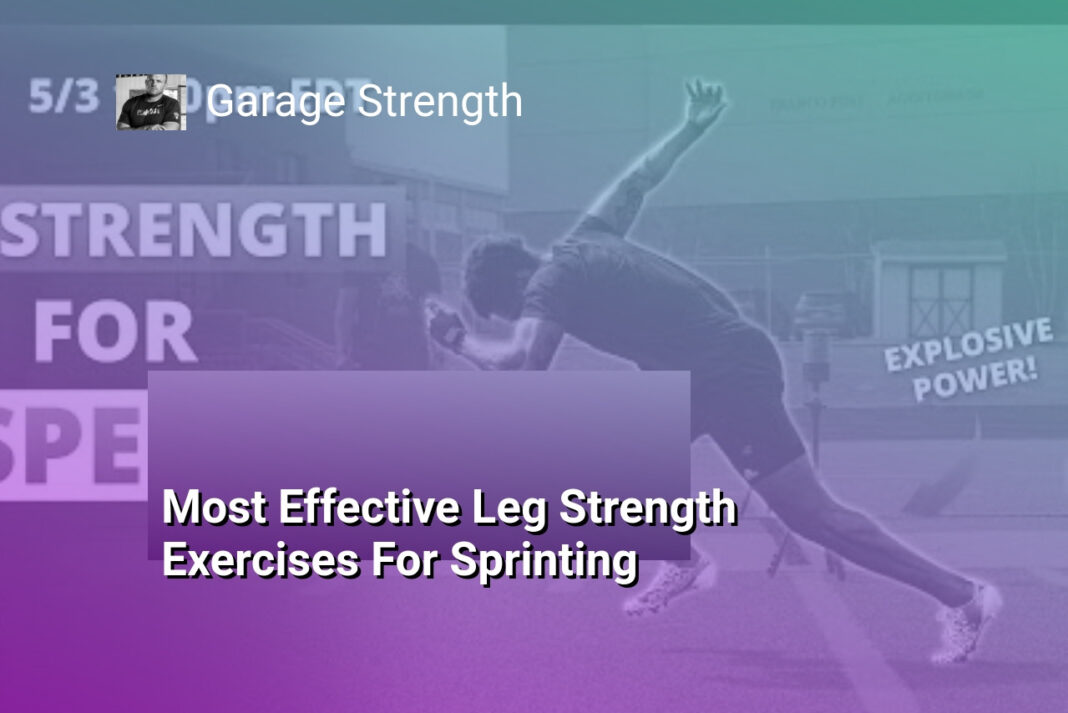The Bottom Line:
Here is a summary of the main points in first-person perspective:
- I believe it’s important to identify the type of strength needed for sprinting, which involves forces up to 5-6 times body weight, and to define sprinting as rapid locomotion at speeds around 17 mph for humans.
- From my perspective, key factors to consider for sprinting strength are maximum voluntary contraction, the short timeline to apply massive force, joint mobility, and the stability needed to enable effective sprinting.
- Research indicates that in untrained individuals, leg strengthening exercises like squats and cleans can improve sprint speed, and intermediately trained individuals also tend to see positive effects from weight room training.
- In my view, weight room training can improve joint integrity, force output, and mobility, but the specific modalities matter, and both sprint work and strength work are needed in the right balance.
- I think exercises that could positively impact sprint speed include resisted sprints with sleds, squats, front squats, and leg press movements, but it’s crucial to incorporate enough actual sprint work along with the strength training for optimal results.
Understanding the Biomechanics and Forces Involved in Sprinting
The Biomechanics of Sprinting
Sprinting is a complex movement that involves the coordination of multiple joints and muscle groups to generate high levels of force and speed. When sprinting, the body experiences ground reaction forces that can reach up to five to six times an individual’s body weight. These forces are applied into the ground and then transferred back into the body, converting vertical energy into horizontal locomotion.
To effectively sprint, an athlete must be able to generate a maximal voluntary contraction and apply it rapidly. This requires not only strength but also the ability to produce force in a very short time frame. The ranges of motion involved in sprinting are relatively similar across individuals, with some variations in technique such as front-side or back-side mechanics.
The Role of Strength Training in Sprinting
Research has shown that strength training can improve sprint speed, particularly in untrained or novice individuals. Exercises such as back squats, front squats, and cleans have been found to increase sprint performance when incorporated into a training program. However, as an athlete becomes more advanced, the relationship between strength training and sprint speed becomes more nuanced.
Strength training can improve joint integrity in the ankle, knee, and hip, which is crucial for sprinting. It can also increase maximal voluntary contractions and force output, particularly at slower speeds and during the acceleration phase. Additionally, strength training can improve mobility and force production in short time frames when the right modalities are used.
Effective Leg Strength Exercises for Sprinting
Some effective leg strength exercises for sprinting include:
1. Sprinting with a sled: This exercise provides resistance while allowing the athlete to maintain proper sprinting mechanics.
2. Back squats and front squats: These exercises target the major muscle groups involved in sprinting, such as the quadriceps, hamstrings, and glutes.
3. Leg press: This exercise can help develop strength in the legs, particularly in the quadriceps.
4. Plyometric exercises: Exercises such as bounding, hopping, and jumping can help improve power and force production in the legs.
Ultimately, a well-rounded training program for sprinting should include a balance of strength training, sprint-specific work, and exercises that target impulse and force production. By understanding the biomechanics and forces involved in sprinting, coaches and athletes can design effective training programs to improve sprint performance.
Defining Sprinting and Its Phases: From Jogging to Top Speed
Understanding the Phases of Sprinting
Sprinting is a form of locomotion that involves moving at high speeds, typically down a track, runway, field, or court. It is important to understand the different phases of sprinting, from jogging to top speed. A walk typically transitions to a jog around 2.5 to 3 miles per hour. When running, the pace is quicker than a jog, usually between 5 and 7 miles per hour, but not yet at sprinting speed. Sprinting involves moving at a rapid clip, with top human speeds reaching around 17 miles per hour, although world-class sprinters can achieve even higher velocities.
Forces and Mechanics Involved in Sprinting
During sprinting, the body experiences ground reaction forces ranging from 4.5 to 6 times the individual’s body weight. These forces are applied into the ground and then transferred back into the body, converting vertical energy into horizontal locomotion. To generate these forces and maintain stability, sprinters require a combination of maximal voluntary contractions, rapid force application within short time frames, and appropriate joint mobility.
The mechanics of sprinting involve both front-side and back-side movements, with research focusing on aspects such as “whip from the hip” to understand how the hip functions at top speeds. Proper joint mobility in the ankle, knee, and hip is crucial for developing sprint speed and maintaining stability during the sprinting motion.
Strength Training for Sprinting Performance
Weight room training can positively impact sprint speed, particularly in untrained or intermediately trained individuals. Exercises such as back squats, front squats, and cleans have been shown to improve sprint performance in these populations. However, the effectiveness of weight room training on elite sprinters is more nuanced and requires further investigation.
Strength training can improve joint integrity in the ankle, knee, and hip, as well as increase maximal voluntary contractions and force output within short time frames when appropriate modalities are used. Incorporating a balance of resistance-based training, unloaded training, and sprint-specific work is essential for optimizing sprint performance and minimizing the risk of injury.
Identifying Key Factors for Sprinting Strength: Stability, Timeline, and Range of Motion
Stability: The Foundation of Sprinting Strength
When it comes to sprinting, stability plays a crucial role in enabling athletes to generate and transfer force effectively. The immense ground reaction forces experienced during sprinting, which can reach up to six times an individual’s body weight, require a solid foundation of stability in the ankles, knees, and hips. Weight room-based training can significantly improve joint integrity and stability, allowing athletes to handle these high forces without compromising their technique or risking injury.
The Timeline of Force Application
Another critical factor in sprinting strength is the timeline of force application. Sprinting involves rapid, explosive movements that occur within extremely short time frames. Athletes must be able to generate maximum voluntary contractions and apply massive amounts of force in these brief moments. Weight room training, when designed with the right modalities, can enhance an athlete’s ability to produce force quickly, improving their acceleration and top-end speed.
Range of Motion: Optimizing Mobility for Sprinting
While stability and force application are essential, they must be accompanied by optimal range of motion in the joints involved in sprinting. Most sprinters exhibit a relatively similar running technique, and research has provided valuable insights into the mechanics of the hip at top speeds. To develop sprint speed effectively, athletes must focus on mobility in the ankles, knees, and hips. Weight room-based training can help improve mobility in these key areas, enabling athletes to achieve the necessary ranges of motion for efficient and powerful sprinting.
The Impact of Weight Room Training on Sprint Speed for Different Populations
The Role of Strength Training in Enhancing Sprint Performance
Weight room training can have a significant impact on sprint speed, particularly for untrained and intermediately trained individuals. Studies have shown that novice individuals who engage in leg strengthening exercises such as back squats, front squats, and cleans can improve their sprint speed over a period of time. This improvement is often associated with an increase in leg strength, as demonstrated by an increase in the amount of weight lifted during these exercises.
For intermediately trained individuals, weight room training can still yield positive results in terms of sprint performance. However, the magnitude of improvement may be less pronounced compared to untrained individuals. This is because intermediately trained individuals have already developed a certain level of strength and power, and further improvements may require more targeted and specific training approaches.
The Importance of Joint Integrity and Mobility in Sprinting
In addition to improving leg strength, weight room training can also enhance joint integrity and mobility, which are crucial factors in sprinting performance. Exercises that target the ankle, knee, and hip joints can help improve stability, range of motion, and force output during sprinting. This is particularly important given the high ground reaction forces experienced by the body during sprinting, which can be up to five to six times an individual’s body weight.
Proper mobility in the joints is essential for efficient sprinting technique and injury prevention. Weight room training can incorporate exercises that focus on improving flexibility and range of motion, such as dynamic stretching, mobility drills, and functional movements. By addressing any limitations or imbalances in joint mobility, athletes can optimize their sprinting mechanics and reduce the risk of injury.
Maximizing Force Output and Impulse in Sprint-Specific Training
While general leg strengthening exercises can provide a foundation for improved sprint performance, it is important to consider the specific demands of sprinting when designing training programs. Sprinting requires the ability to generate high levels of force in a very short time frame, known as impulse. Weight room training can be tailored to improve maximal voluntary contractions and force output at high speeds, which are critical for sprint performance.
Incorporating exercises that emphasize explosive movements, such as plyometrics, Olympic lifts, and ballistic training, can help develop the specific strength and power qualities needed for sprinting. These exercises should be performed with proper technique and progressively overloaded to ensure continued adaptation and improvement.
However, it is crucial to strike a balance between strength training and sprint-specific work. While weight room training can enhance the underlying physical qualities necessary for sprinting, it should be complemented by actual sprinting sessions and technique work. This holistic approach ensures that athletes are developing both the strength and the specific skills required for optimal sprint performance.
Top Leg Strengthening Exercises for Boosting Sprint Performance
Squats: The Foundation of Leg Strength
Squats are one of the most effective exercises for building overall leg strength and power. They target the quadriceps, hamstrings, glutes, and calves, making them a comprehensive exercise for sprinters. Variations such as back squats, front squats, and goblet squats can be incorporated into a training program to provide variety and target different muscle groups. When performing squats, it’s crucial to maintain proper form, with a neutral spine, knees tracking over the toes, and the weight distributed evenly through the feet.
Plyometric Exercises: Developing Explosive Power
Plyometric exercises are essential for developing the explosive power needed for sprinting. These exercises involve rapid stretching and contracting of the muscles, which helps to improve the rate of force development. Examples of plyometric exercises include box jumps, bounding, and single-leg hops. When incorporating plyometrics into a training program, it’s important to start with low-intensity exercises and gradually progress to more challenging variations as strength and technique improve.
Deadlifts and Romanian Deadlifts: Targeting the Posterior Chain
Deadlifts and Romanian deadlifts are excellent exercises for targeting the posterior chain, which includes the hamstrings, glutes, and lower back. These muscles play a crucial role in sprinting, as they help to generate power during the push-off phase of the stride. When performing deadlifts, it’s important to maintain a neutral spine and engage the core to prevent injury. Romanian deadlifts, which involve a slight bend in the knees and a focus on hinging at the hips, can be particularly effective for targeting the hamstrings.
By incorporating these leg strengthening exercises into a well-rounded training program, sprinters can develop the strength and power needed to improve their performance on the track. It’s important to remember that while these exercises are effective, they should be combined with sprint-specific drills and technique work to maximize results.





